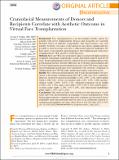| dc.contributor.author | S. Wallins, Joseph | en_US |
| dc.contributor.author | Chandawarkar, Akash A. | en_US |
| dc.contributor.author | Dobry, Allison | en_US |
| dc.contributor.author | Diaz-Siso, J. Rodrigo | en_US |
| dc.contributor.author | Bueno, Ericka M. | en_US |
| dc.contributor.author | Caterson, Edward J. | en_US |
| dc.contributor.author | Jania, Camille | en_US |
| dc.contributor.author | Hevelone, Nathanael D. | en_US |
| dc.contributor.author | Lipsitz, Stuart R. | en_US |
| dc.contributor.author | Mukundan, Srinivasan | en_US |
| dc.contributor.author | Pomahac, Bohdan | en_US |
| dc.date.accessioned | 2015-07-13T18:45:01Z | |
| dc.date.issued | 2015 | en_US |
| dc.identifier.citation | S. Wallins, J., A. A. Chandawarkar, A. Dobry, J. R. Diaz-Siso, E. M. Bueno, E. J. Caterson, C. Jania, et al. 2015. “Craniofacial Measurements of Donors and Recipients Correlate with Aesthetic Outcome in Virtual Face Transplantation.” Plastic and Reconstructive Surgery Global Open 3 (5): e385. doi:10.1097/GOX.0000000000000343. http://dx.doi.org/10.1097/GOX.0000000000000343. | en |
| dc.identifier.issn | 2169-7574 | en |
| dc.identifier.uri | http://nrs.harvard.edu/urn-3:HUL.InstRepos:17295551 | |
| dc.description.abstract | Background: Face transplantation is an increasingly feasible option for patients with severe disfigurement. Donors and recipients are currently matched based on immune compatibility, skin characteristics, age, and gender. Aesthetic outcomes of the match are not always optimal and not possible to study in actual cases due to ethical and logistical challenges. We have used a reproducible and inexpensive three-dimensional virtual face transplantation (VFT) model to study this issue. Methods: Sixty-one VFTs were performed using reconstructed high-resolution computed tomography angiographs of male and female subjects aged 20–69 years. Twenty independent reviewers evaluated the level of disfigurement of the posttransplant models. Absolute differences in 9 soft-tissue measurements and 16 bony cephalometric measurements from each of the VFT donor and recipient pretransplant model pairs were correlated to the reviewers’ evaluation of disfigurement after VFT through a multivariate logistic regression model. Results: Five soft-tissue measurements and 3 bony measurements were predictive of the rating of disfigurement after VFT (odds ratio; 95% confidence interval): trichion-to-nasion facial height (1.106; 1.066–1.148), endocanthal width (1.096; 1.051–1.142), exocanthal width (1.067; 1.036–1.099), mouth/chelion width (1.064; 1.019–1.110), subnasale-to-menton facial height (1.029; 1.003–1.056), inner orbit width (1.039; 1.009–1.069), palatal plane/occlusal plane angle (1.148; 1.047–1.258), and sella-nasion/mandibular plane angle (1.079; 1.013–1.150). Conclusions: This study provides early evidence for the importance of soft-tissue and bony measurements in planning of facial transplantation. With future improvements to immunosuppressive regimens and increased donor availability, these measurements may be used as an additional criterion to optimize posttransplant outcomes. | en |
| dc.language.iso | en_US | en |
| dc.publisher | Wolters Kluwer Health | en |
| dc.relation.isversionof | doi:10.1097/GOX.0000000000000343 | en |
| dc.relation.hasversion | http://www.ncbi.nlm.nih.gov/pmc/articles/PMC4457248/pdf/ | en |
| dash.license | LAA | en_US |
| dc.title | Craniofacial Measurements of Donors and Recipients Correlate with Aesthetic Outcome in Virtual Face Transplantation | en |
| dc.type | Journal Article | en_US |
| dc.description.version | Version of Record | en |
| dc.relation.journal | Plastic and Reconstructive Surgery Global Open | en |
| dash.depositing.author | Dobry, Allison | en_US |
| dc.date.available | 2015-07-13T18:45:01Z | |
| dc.identifier.doi | 10.1097/GOX.0000000000000343 | * |
| dash.authorsordered | false | |
| dash.contributor.affiliated | Mukundan, Srinivasan | |
| dash.contributor.affiliated | Dobry, Allison S. | |
| dash.contributor.affiliated | Pomahac, Bohdan | |
| dash.contributor.affiliated | Bueno, Ericka M. | |
| dash.contributor.affiliated | Caterson, Edward | |
| dash.contributor.affiliated | Lipsitz, Stuart | |


